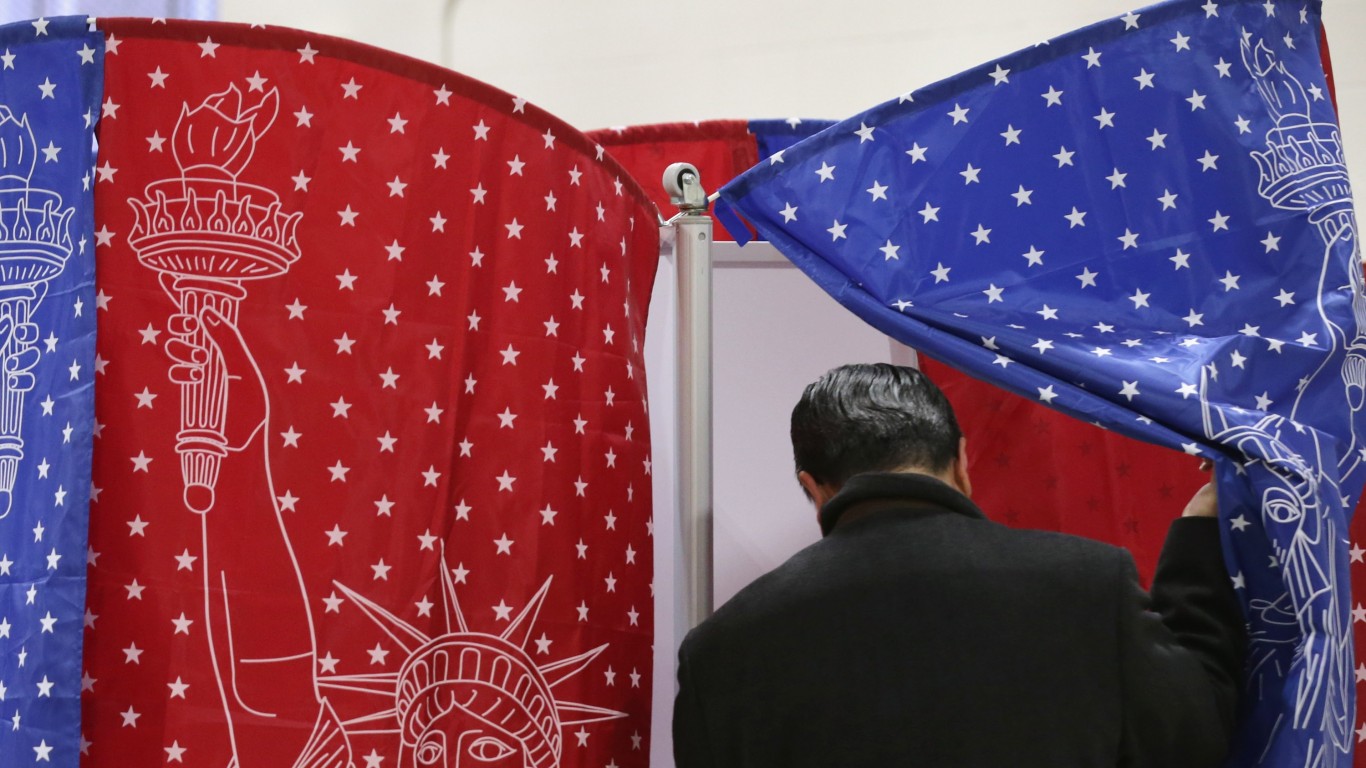

As Election Day draws closer, President Donald Trump and Democratic opponent Joe Biden are entering the final weeks of their campaigns. In the race for 270 electoral votes — the majority needed to win the White House — both candidates have spent hundreds of millions of dollars to garner support from voters across the country. While broad national support is important, the winner will likely be decided by voters in only a handful of closely contested, politically divided states.
Going into the 2020 election, the political leanings of the majority of states are mostly decided. States in the Northeast and along the West Coast tend to be more liberal, and their electoral votes will almost certainly go to Biden, the Democratic candidate. Meanwhile, Southern states as well as many in the Midwest, are more conservative, and Trump, the Republican candidate, is counting on their support.
There are over a dozen states, however, where the outcome on Election Day is not a foregone conclusion. The political divide in these states means that they are either too close to call or could likely vote counter to the prevailing political sentiment in the state. In many battleground states, urban areas tend to be more liberal, and rural areas tend to be more conservative. Here is a look at the most Democratic county and the most Republican county in each state.
To determine who would win in battleground states if the presidential election was held today, 24/7 Wall St. reviewed polling data from RealClearPolitics, a political news and analysis outlet. The margin of victory shown reflects an average of results from multiple local and national polling agencies that often utilize different prediction models. Our list also includes congressional districts in Maine and Nebraska — two states that split their electoral votes — for which polling data is unavailable.
Of course, the election is not today, and much can change in the weeks leading up to Nov. 3. At this juncture in the 2016 presidential election, Democratic Party nominee Hillary Clinton had a slight advantage over Trump in the national polls as well as a strong lead in several key battleground states, including Michigan, Pennsylvania, and Wisconsin. Clinton ended up losing each of these states — and the election along with them.
One factor that could decide the winning candidate in many of the states on this list is voter turnout. Participation rates among eligible voters can fluctuate from one election to another, and motivation among likely voters remains a critical unknown factor going into election day. As has been the case in recent presidential elections, high voter turnout will likely benefit the Democratic Party in 2020. Here is a look at the states with the highest voter turnout.
Click here to see who would win in battleground states if the presidential election was today
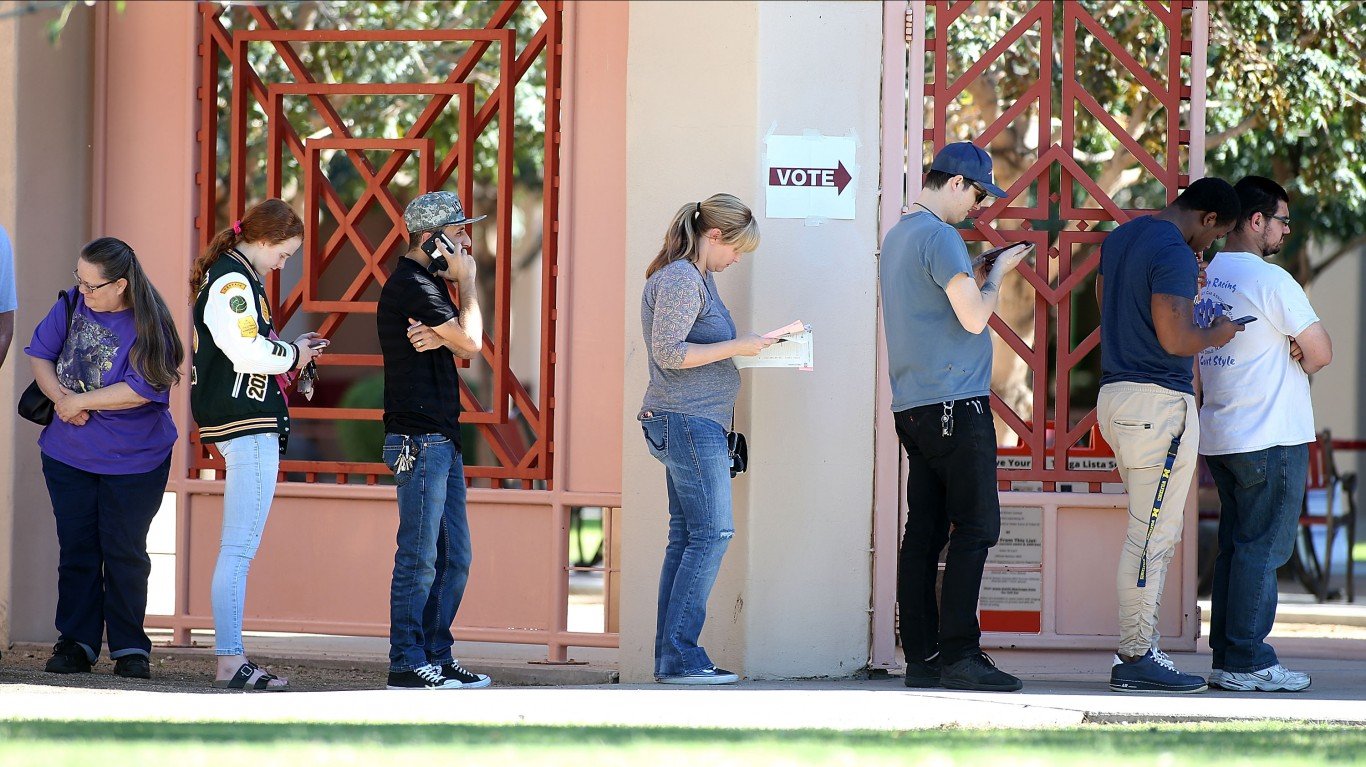
1. Arizona
> Electoral votes: 11
> Who would win today: Joe Biden; +4.7 point avg. spread
> Winner in 2016 election: Donald Trump; +3.5 points
> Nov. 2016 voter participation: 53.3% (10th lowest)
President Donald Trump won Arizona’s 11 electoral votes in 2016 by a 3.5 point margin over his Democratic challenger Hillary Clinton. Though Arizona has not voted for the Democratic presidential candidate since 1996, this year, it has become a battleground state. In fact, most major polls in the state have Democratic nominee Joe Biden ahead of the incumbent president by several points as of mid-September.
Several factors may help explain Arizona’s apparent shift to the left. First, the state has a large and growing Latino population, a demographic that votes largely Democratic. Additionally, the sprawling Phoenix metro area is home to about two-thirds of the state’s population, and suburban voters have become increasingly likely to vote Democratic since 2016 — both in Arizona and nationwide.
[in-text-ad]
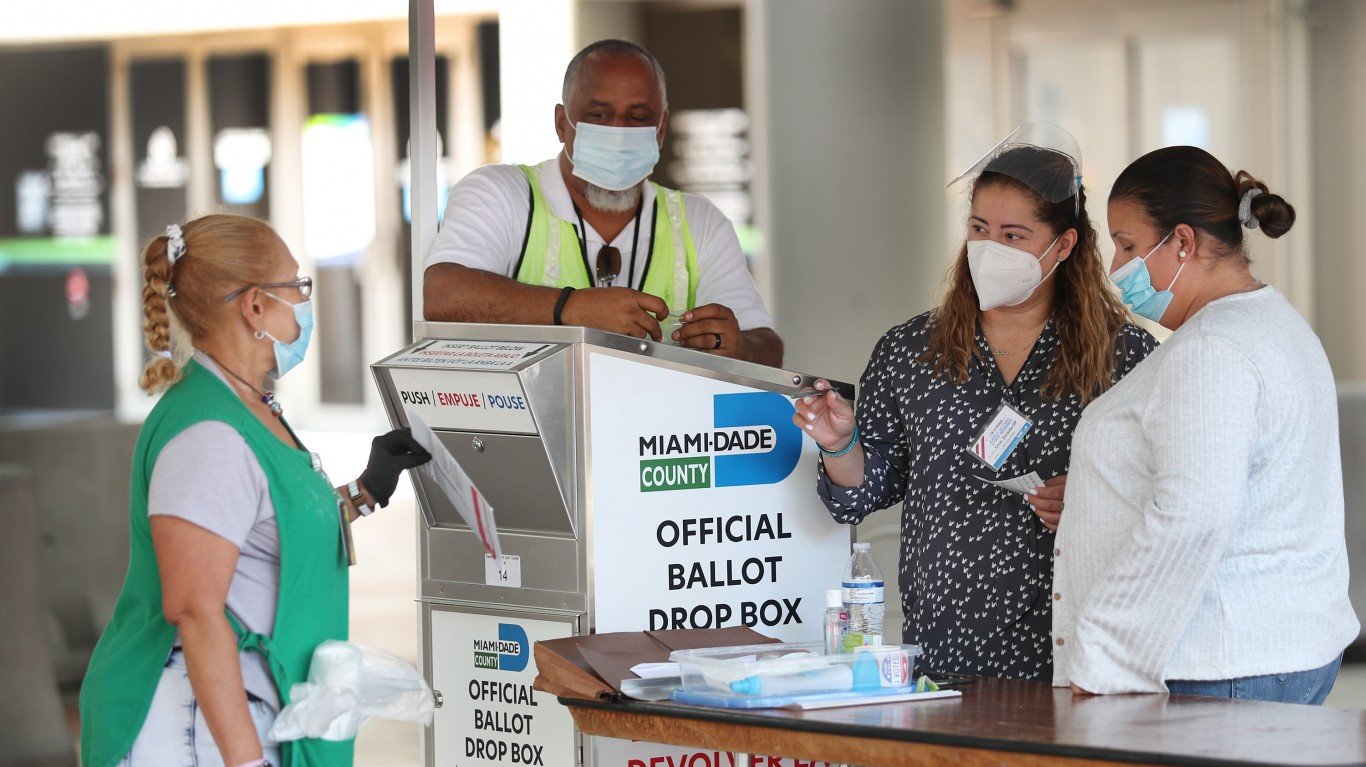
2. Florida
> Electoral votes: 29
> Who would win today: Joe Biden; +1.6 point avg. spread
> Winner in 2016 election: Donald Trump; +1.2 points
> Nov. 2016 voter participation: 52.9% (8th lowest)
Worth 29 electoral votes, Florida has historically been one of the most coveted and hotly contested battleground states — and this year is no different. The Sunshine State went to Republican George W. Bush in both 2000 and 2004 before going to Democrat Barack Obama in 2008 and 2012. Though Florida went to Trump in 2016 by a slim 1.2 point margin, Biden currently has a slight advantage in the polls.
Florida is a massive state, home to over 21 million people of a wide range of demographic backgrounds and political interests — and as a result, there is no prototypical Florida voter. Appealing to the broadest possible segment of voters in the state is critical for both Trump and Biden. The last candidate to win the presidency without winning Florida was Bill Clinton in 1992.

3. Georgia
> Electoral votes: 16
> Who would win today: Donald Trump; +1.3 point avg. spread
> Winner in 2016 election: Donald Trump; +5.1 points
> Nov. 2016 voter participation: 55.7% (15th lowest)
Since going to its native son Jimmy Carter in 1980, the only time Georgia’s electoral votes went to a Democrat in the last 40 years was in the 1992 election, when the state went to Bill Clinton. Though Donald Trump won the state by a 5.1 point margin in 2016, Georgia has become more diverse in the years since — a factor driven in part by the growth of the Atlanta suburbs. Currently, some polls are putting Trump ahead in the state, while others are showing an advantage for Biden.

4. Iowa
> Electoral votes: 6
> Who would win today: Donald Trump; +1.7 point avg. spread
> Winner in 2016 election: Donald Trump; +9.4 points
> Nov. 2016 voter participation: 60.7% (19th highest)
Since the 1988 election, Iowa has only gone to a Republican twice — first to George W. Bush in 2004, and again to Donald Trump in 2016. The state appears to be shifting to the right as the Republican Party has solidified the support of working class white voters. Though current projections give Trump a slight advantage in the state, Biden is by no means out of contention in Iowa.
[in-text-ad-2]
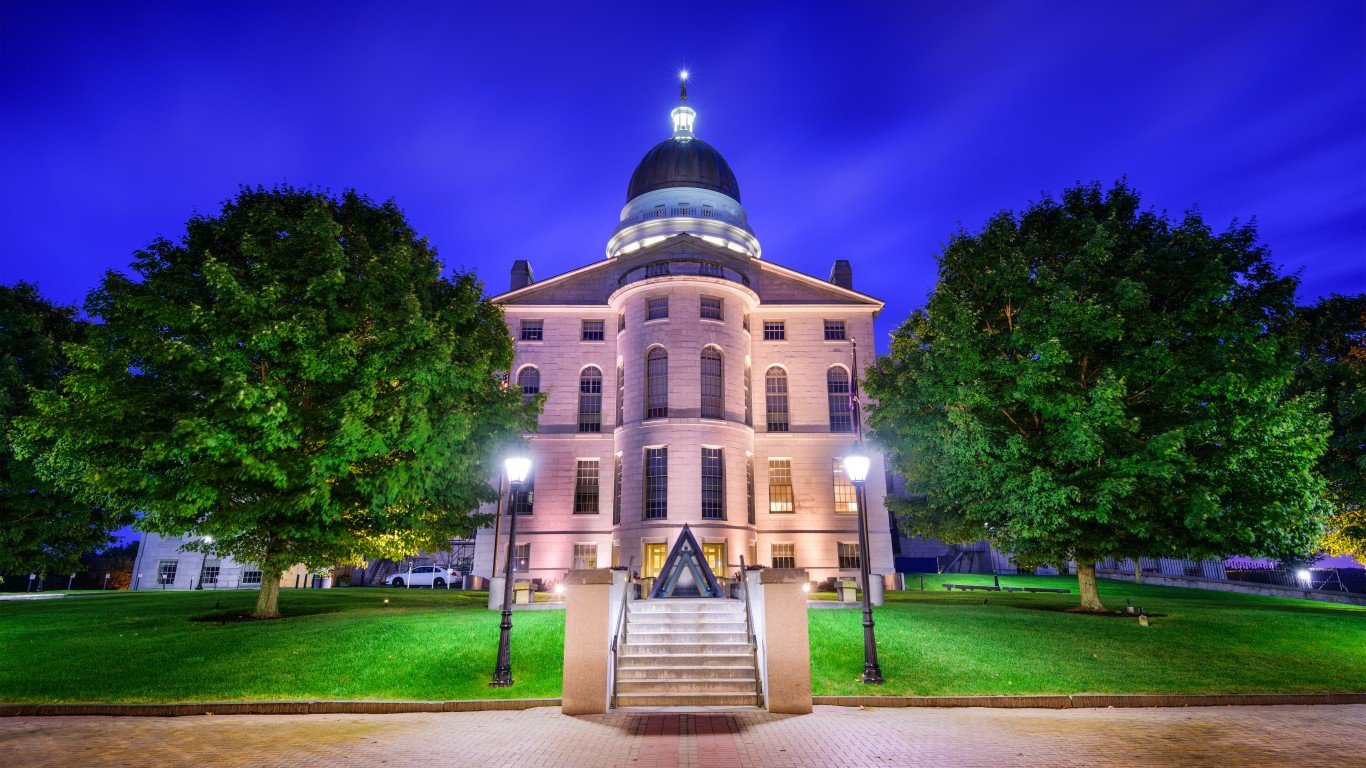
5. Maine 2nd District
> Electoral votes: 1
> Who would win today: N/A
> Winner in 2016 election: Donald Trump; +10.3 points
> Nov. 2016 voter participation: 71.3% (the highest)
Along with Nebraska, Maine is one of only two states that does not allocate all of its electoral votes to the statewide winner. As a result, the state’s 2nd Congressional District, a largely rural area that spans the entirety of the state north of Portland and Augusta, could easily go to either Trump or Biden. In 2016, Maine’s 2nd District went to Trump, and the rest of the state went to Clinton. This year, Maine’s 2nd District, and its single electoral vote, is the only part of the state considered up for grabs as early polls indicate the rest of the state will most likely go to Biden.
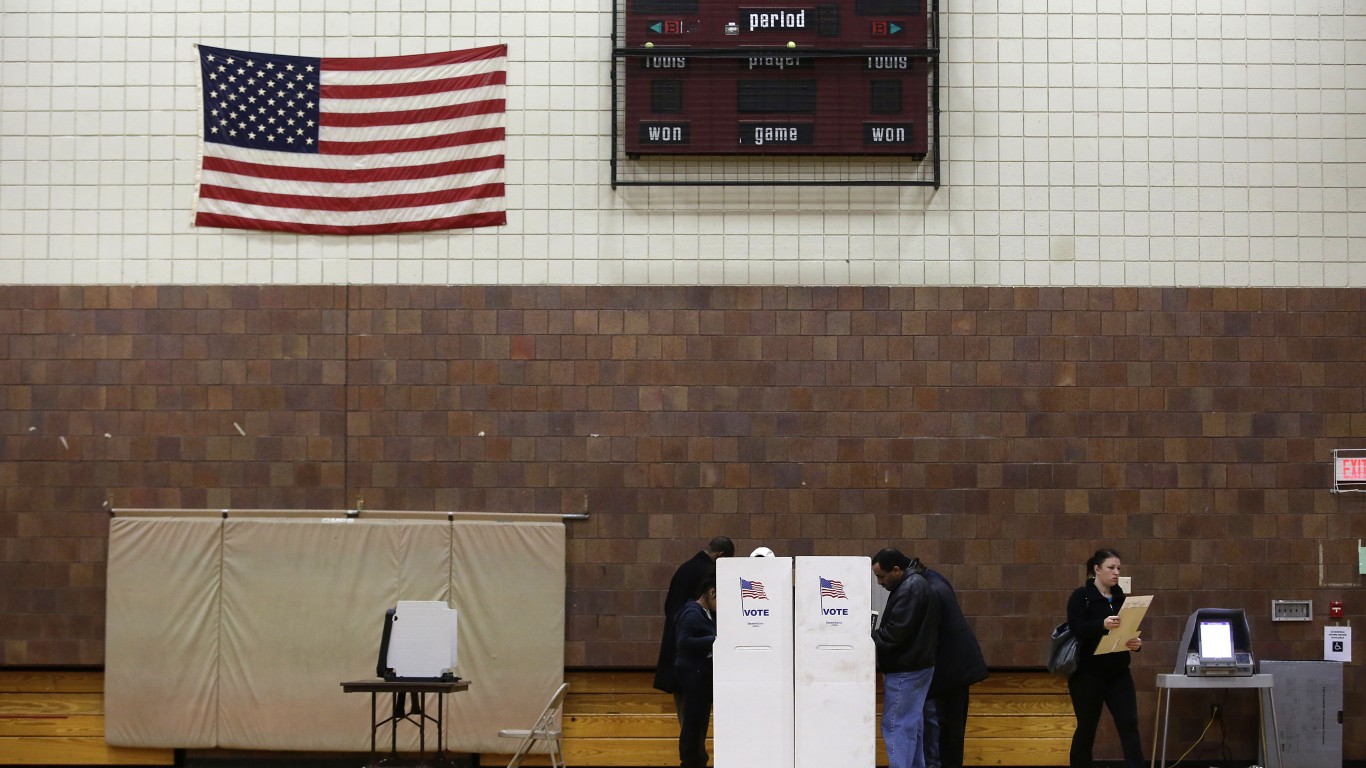
6. Michigan
> Electoral votes: 16
> Who would win today: Joe Biden; +4.2 point avg. spread
> Winner in 2016 election: Donald Trump; +0.2 point
> Nov. 2016 voter participation: 61.8% (13th highest)
The November 2016 presidential election marked the first time in nearly two decades that Michigan’s electoral votes went to a Republican. This year, the state is one of several in the Midwest that stands out as a closely contested political battleground. Both Trump, who recently visited Saginaw County, a blue collar stronghold, and Biden, who recently spoke at the United Auto Workers headquarters in Warren, have been campaigning strategically for the state’s 16 electoral votes that could prove to be critical in winning the presidency. Most polls are showing that Biden has a slight lead in the state.
[in-text-ad]

7. Minnesota
> Electoral votes: 10
> Who would win today: Joe Biden; +10.2 point avg. spread
> Winner in 2016 election: Hillary Clinton; +1.5 points
> Nov. 2016 voter participation: 65.3% (5th highest)
Minnesota’s electoral votes have not gone to a Republican candidate in nearly five decades. That may soon change, however, as the state has moved to the right in recent years. Though major cities in Minnesota are largely left of center, Hillary Clinton won the state in 2016 by a slim 1.5 point margin.
Trump has made several campaign-style visits to Minnesota as president, presumably with the goal of rallying the state’s rural conservative voting bloc. To win the state, Trump will need a decisive victory in rural Minnesota — including the Iron Range, an area where iron mining and production is an economic pillar. Stil, Biden leads in the statewide polls show, and as of mid-September, his lead appeared to be widening.
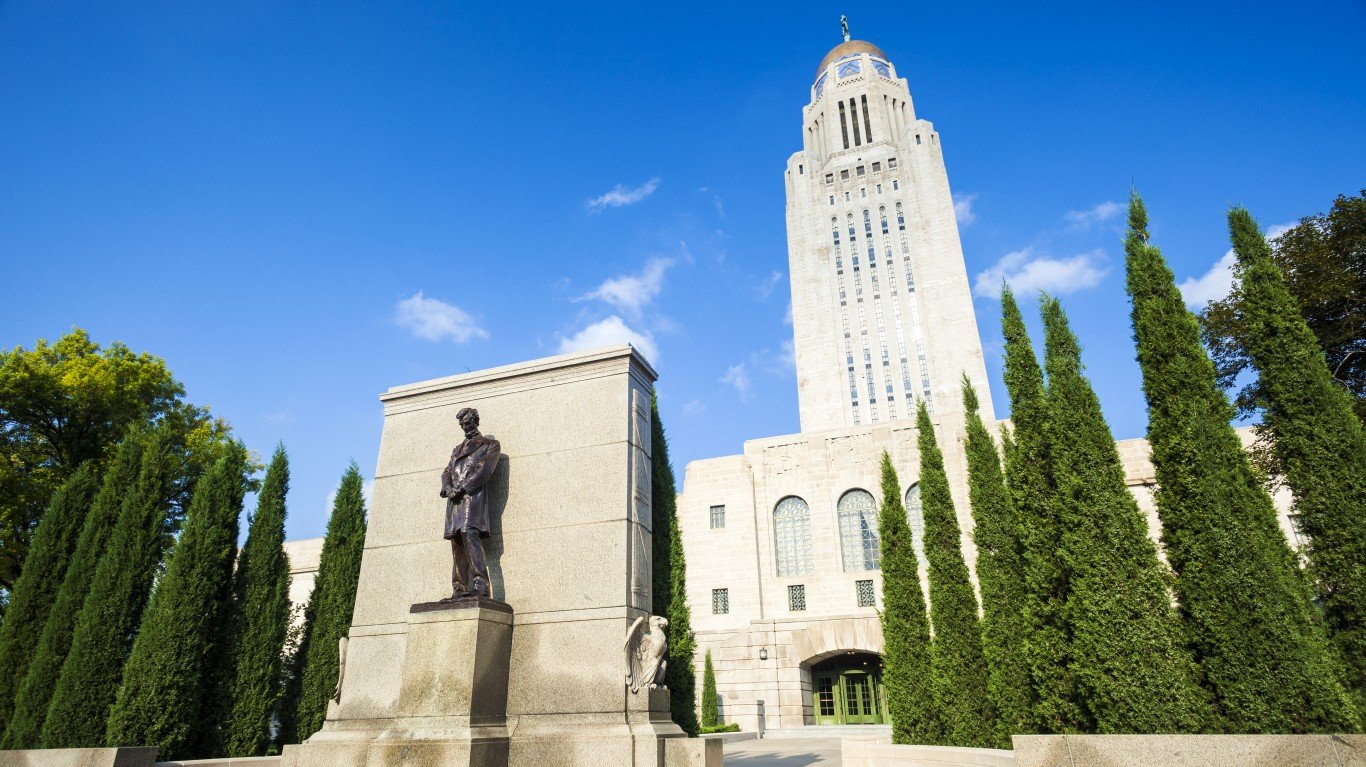
8. Nebraska 2nd District
> Electoral votes: 1
> Who would win today: N/A
> Winner in 2016 election: Donald Trump; +2.2 points
> Nov. 2016 voter participation: 63.4% (9th highest)
Along with Maine, Nebraska is one of only two states that does not allocate all of its electoral votes to the statewide winner. As a result, Nebraska’s 2nd Congressional District, which covers the Omaha area, is up for grabs this election. The area, which went to Obama in 2008, has only one electoral vote, however, and will not likely be a campaign hotspot for either candidate.
While Nebraska’s 2nd Congressional District could realistically go to either party this year, the rest of the state reliably votes Republican.

9. Nevada
> Electoral votes: 6
> Who would win today: Joe Biden; +6.0 point avg. spread
> Winner in 2016 election: Hillary Clinton; +2.4 points
> Nov. 2016 voter participation: 53.5% (12th lowest)
Since Republican candidate George W. Bush won the White House in 2004 with the help of Nevada’s electoral votes, the state has gone to the Democratic candidate every presidential election. In 2016, Clinton won the state by a small 2.4 point margin, and while Democrats have a slight lead in the polls going into the 2020 election, Trump could still walk away with six electoral votes from Nevada this November. Should the Republican ticket take the state this year, it will likely be the result of low overall voter turnout, but strong participation among the state’s large and growing retirement age population.
[in-text-ad-2]

10. New Hampshire
> Electoral votes: 4
> Who would win today: Joe Biden; +5.5 point avg. spread
> Winner in 2016 election: Hillary Clinton; +0.4 point
> Nov. 2016 voter participation: 66.9% (3rd highest)
New Hampshire is the only state in the New England region that polls show could foreseeably go to Trump this year. New Hampshire is home to a large rural conservative voting bloc, and Clinton won the state’s four electoral votes in 2016 by a razor thin 0.4 point margin.
Despite its status as a swing state, neither Trump nor Biden have allocated substantial campaign resources to New Hampshire — likely because the four electoral votes up for grabs will contribute very little to the 270 ultimately needed to win. Currently, Biden has an advantage in the polls in New Hampshire.
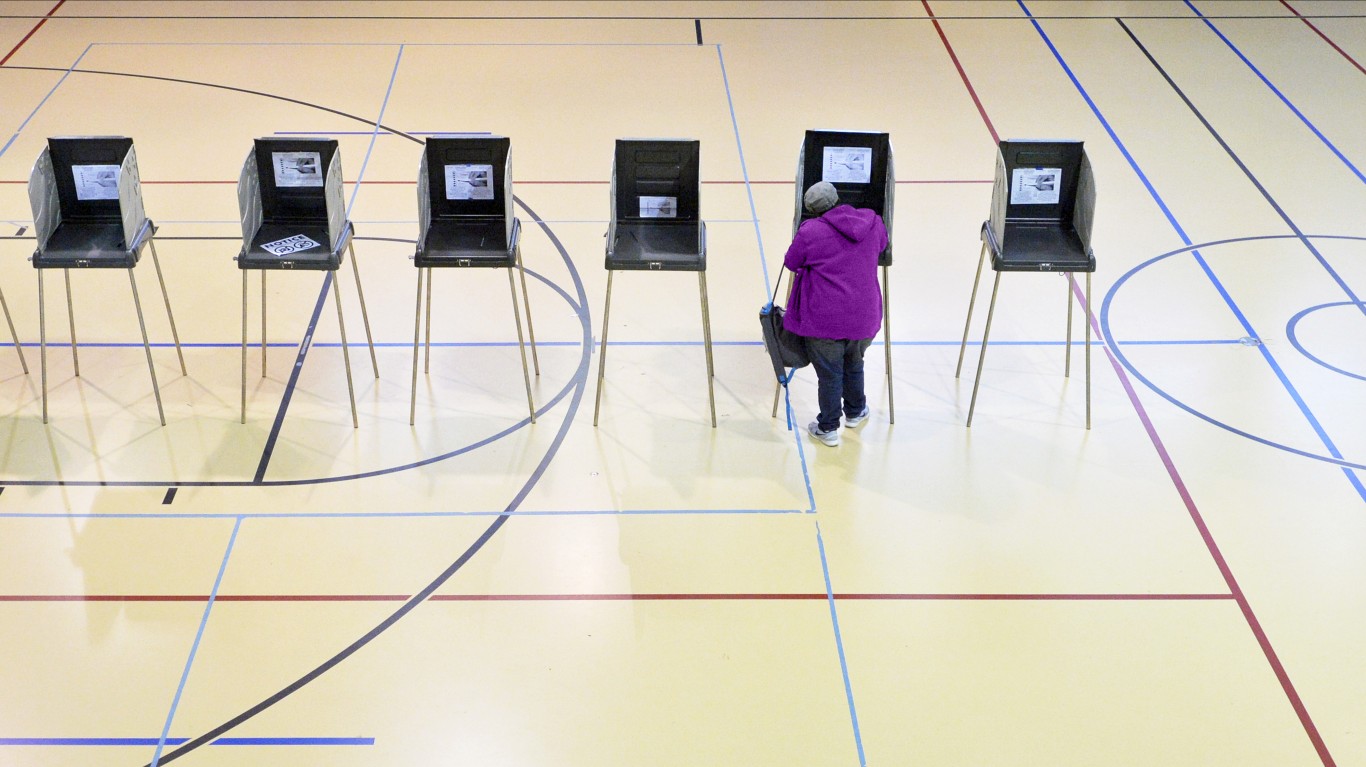
11. North Carolina
> Electoral votes: 15
> Who would win today: Joe Biden; +0.7 point avg. spread
> Winner in 2016 election: Donald Trump; +3.7 points
> Nov. 2016 voter participation: 61.6% (15th highest)
North Carolina is one of only a few states in the southeastern U.S. where Biden stands a chance in November. The vote in the state is split between white, rural, largely conservative voters and more diverse populations in cities and suburbs who tend to be more moderate or left leaning.
The state, worth a considerable 15 electoral votes, is one of the most closely contested races in the country. Though Trump defeated Clinton in the state in 2016 by a 3.7 point margin, Biden currently holds a slight edge over the president in most polls.
[in-text-ad]
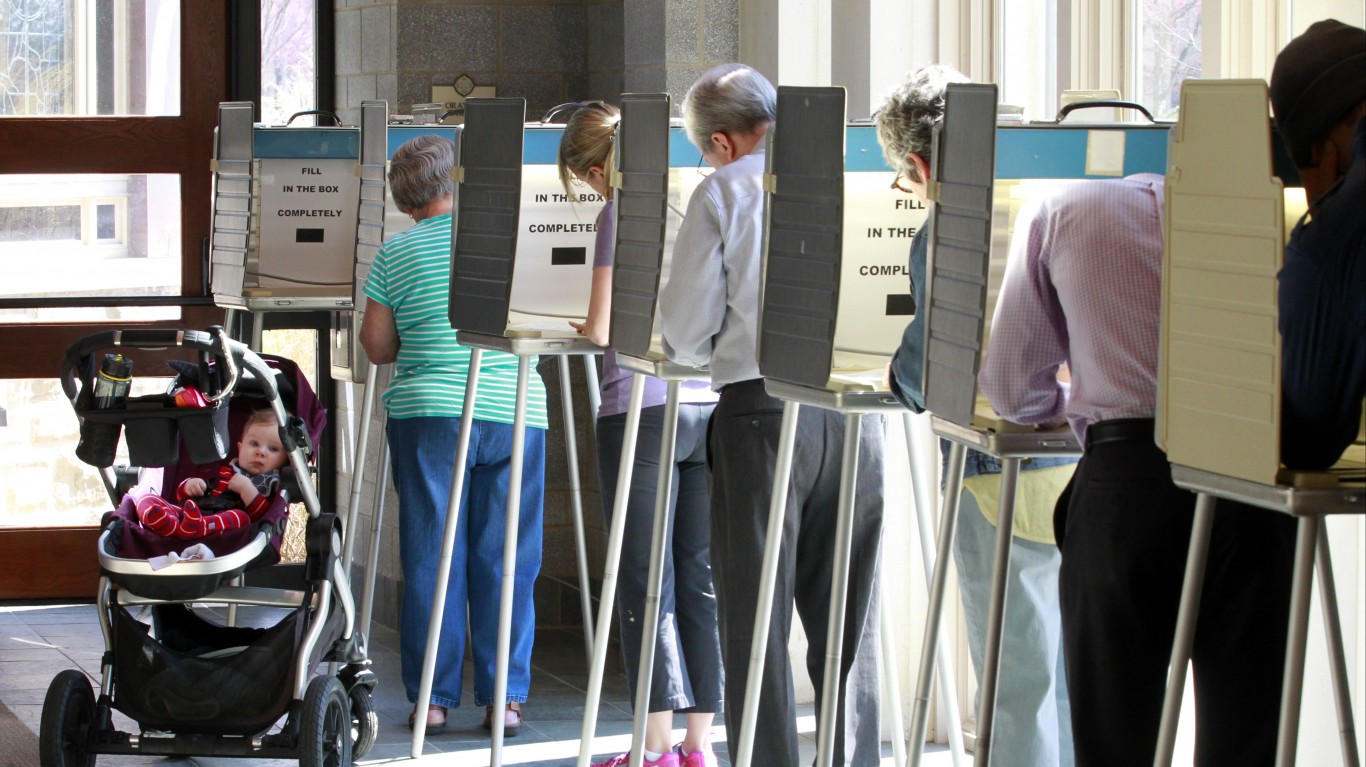
12. Ohio
> Electoral votes: 18
> Who would win today: Joe Biden; +2.4 point avg. spread
> Winner in 2016 election: Donald Trump; +8.1 points
> Nov. 2016 voter participation: 61.4% (16th highest)
No candidate has won the White House without winning Ohio since 1960, when John F. Kennedy was elected president. Though Trump had a decisive victory in the Buckeye State in 2016, strong turnout among the state’s Black voters in cities could turn the state blue in November. Despite evidence that Ohio is becoming a red state, most polls now show that Biden is slightly more likely to secure the state’s 18 electoral votes than Trump.

13. Pennsylvania
> Electoral votes: 20
> Who would win today: Joe Biden; +4.3 point avg. spread
> Winner in 2016 election: Donald Trump; +0.7 poins
> Nov. 2016 voter participation: 60.2% (21st highest)
Home to nearly 13 million people, Pennsylvania is worth a substantial 20 electoral votes. In 2016, Trump became the first Republican presidential candidate to win Pennsylvania since George H.W. Bush in 1988, edging out Clinton by just 0.7 point.
While major cities in Pennsylvania, including Philadelphia, are Democratic strongholds, the state’s rural areas tend to be staunchly conservative. Pennsylvania suburbs are generally more moderate. Currently, most polls identify Biden as the frontrunner in the Keystone State.
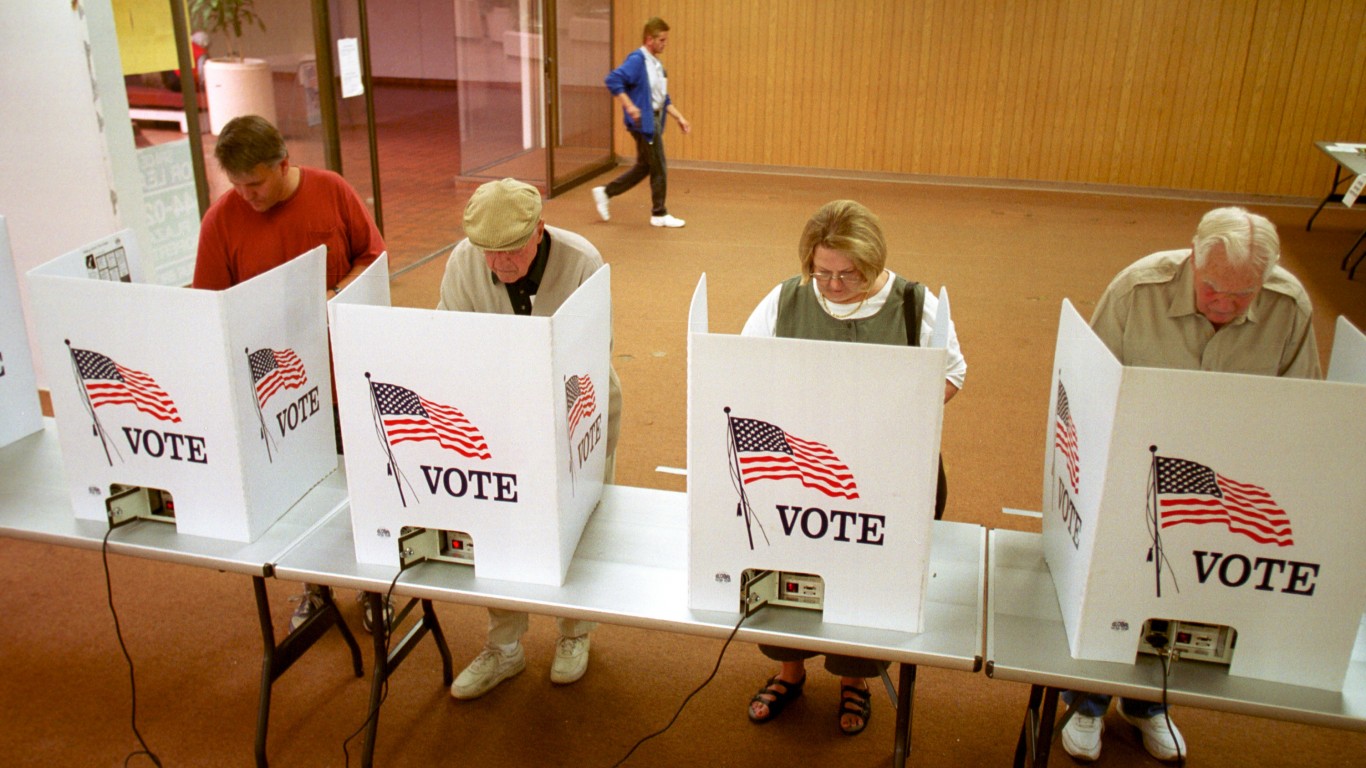
14. Texas
> Electoral votes: 38
> Who would win today: Donald Trump; +3.5 point avg. spread
> Winner in 2016 election: Donald Trump; +9.0 points
> Nov. 2016 voter participation: 47.7% (2nd lowest)
No Democrat has won the Lone Star State since Jimmy Carter did in 1976. Last election, Trump won Texas by a decisive 9 point margin. However, as the state has grown more racially diverse in recent years and its white suburban voters have become more moderate, Texas is no longer a state the Democrats can write off. Still, most polls are showing Trump with a clear advantage in Texas.
[in-text-ad-2]

15. Wisconsin
> Electoral votes: 10
> Who would win today: Joe Biden; +6.7 point avg. spread
> Winner in 2016 election: Donald Trump; +0.8 point
> Nov. 2016 voter participation: 68.7% (2nd highest)
In a narrow upset, Trump became the first Republican presidential candidate to win Wisconsin since Ronald Reagan in 1984. The cities of Milwaukee and Madison are liberal strongholds, while much of the rest of the state is more moderate. Both Trump and Biden are directing campaign efforts in Wisconsin to secure the state’s 10 electoral votes.
Despite Trump’s victory in the Midwestern state in 2016, Biden currently has a clear advantage in the polls.
Sponsored: Find a Qualified Financial Advisor
Finding a qualified financial advisor doesn’t have to be hard. SmartAsset’s free tool matches you with up to 3 fiduciary financial advisors in your area in 5 minutes. Each advisor has been vetted by SmartAsset and is held to a fiduciary standard to act in your best interests. If you’re ready to be matched with local advisors that can help you achieve your financial goals, get started now.
Thank you for reading! Have some feedback for us?
Contact the 24/7 Wall St. editorial team.



